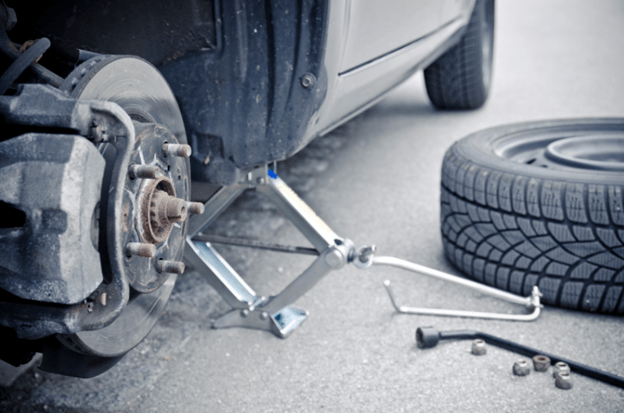HOW TO CHANGE A FLAT TIRE
Have you ever experienced a flat tire? If so, you know that they don’t typically happen when it is convenient for the driver.
Don't wait until it’s too late to find out if you have the proper tools and knowledge to change the flat tire yourself!

Familiarizing yourself with the tools you’ll need in the comfort of your own driveway is a great place to start in being prepared for a flat tire.
Take a quick inventory of the tools that you will need to change your tire: jack, lug wrench, lug nut key, and a spare tire. Other tools that aren't required, but make the job a little easier are: flashlight, gloves, wheel chocks, portable tire inflator, and a tire pressure gauge. Road flares are also a great addition to your emergency bag. *See your owner's manual for additional information.
It is also important to check your spare tire every 6 months to make sure it is properly inflated. This is something we check for you when doing a safety inspection, which is included with every service!
If you find yourself with a flat tire, stay calm, slow down, turn on your emergency lights and find a safe, flat area to pull over. It is important to find a safe area where you will be visible to other drivers, and a flat area so your vehicle will be stable on the jack.
ONCE SAFELY PULLED OVER FOLLOW THESE STEPS:
-
-
turn off your vehicle
-
Apply your parking brake and ensure the vehicle is in park or forward gear
-
If you have wheel chocks, put these in place now
-
Remove the wheel cover or hub cap if you have one
-
Place the jack and lift your vehicle a few inches to remove weight from the wheel, but keep the tire touching the ground so it does not spin *see your owner's manual to find out where to place the jack
-
Use the lug wrench to loosen the lug nuts (if you have a lug nut key you will put that in place now in order to loosen the lug nuts)
-
Continue to lift until the tire is all the way off of the ground
-
Remove all lug nuts
-
Pull the tire toward you to remove it
-
Mount the spare tire, aligning the tire rim with the wheel studs
-
Replace the lug nuts and tighten them by hand
-
Lower your vehicle so the tire touches the ground, but don't lower it all of the way
-
Tighten the lug nuts with the lug wrench in a star pattern
-
Lower your vehicle completely
-
When you have successfully installed your spare tire, it is now safe to drive. Spare tires should only be used temporarily. You should not drive over 50 miles or go more than 50 MPH while driving on your spare tire.

